2018 TOYOTA AVENSIS wheel
[x] Cancel search: wheelPage 263 of 660
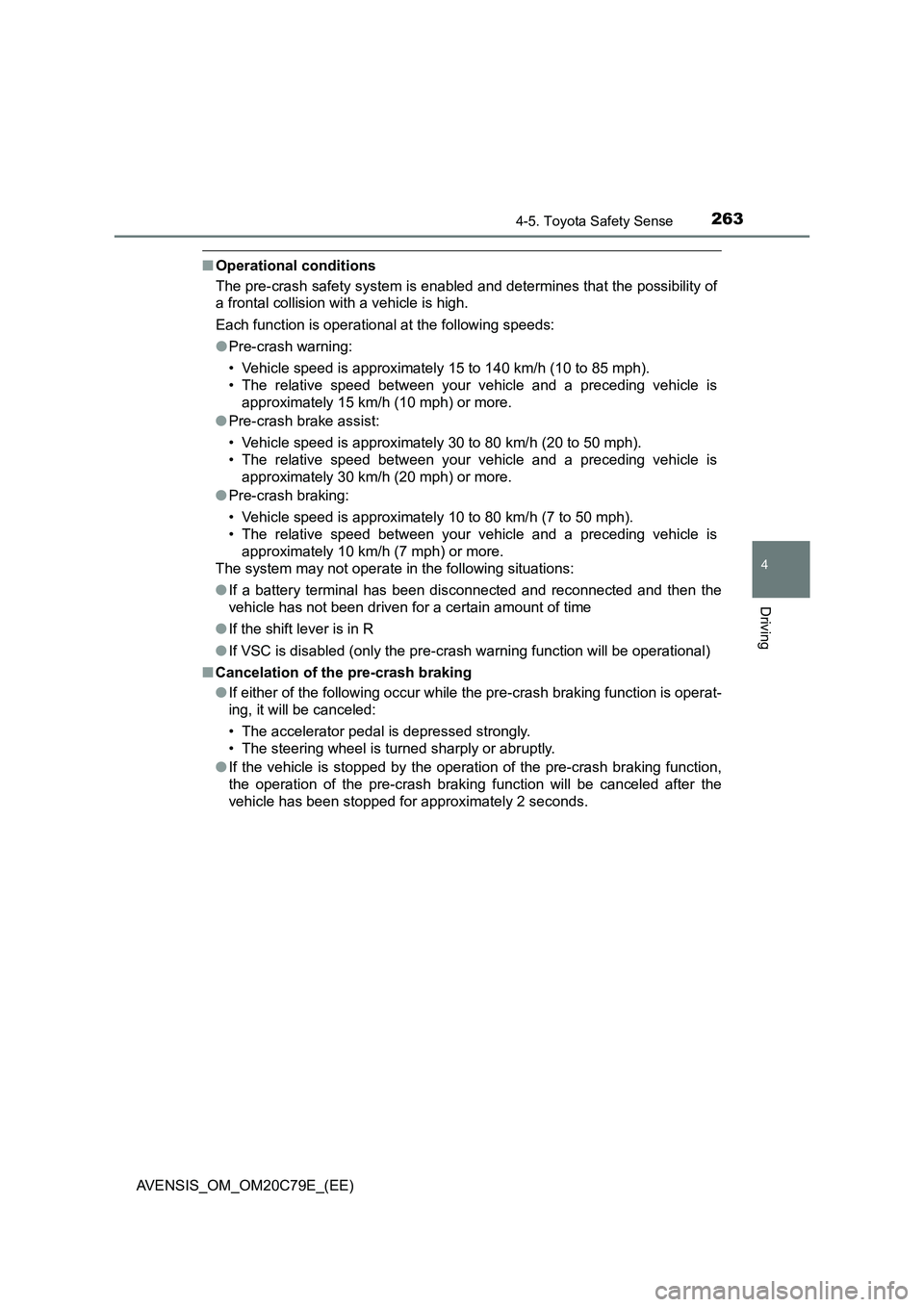
2634-5. Toyota Safety Sense
4
Driving
AVENSIS_OM_OM20C79E_(EE)
■Operational conditions
The pre-crash safety system is enabled and determines that the possibility of
a frontal collision with a vehicle is high.
Each function is operational at the following speeds:
●Pre-crash warning:
• Vehicle speed is approximately 15 to 140 km/h (10 to 85 mph).
• The relative speed between your vehicle and a preceding vehicle is
approximately 15 km/h (10 mph) or more.
●Pre-crash brake assist:
• Vehicle speed is approximately 30 to 80 km/h (20 to 50 mph).
• The relative speed between your vehicle and a preceding vehicle is
approximately 30 km/h (20 mph) or more.
●Pre-crash braking:
• Vehicle speed is approximately 10 to 80 km/h (7 to 50 mph).
• The relative speed between your vehicle and a preceding vehicle is
approximately 10 km/h (7 mph) or more.
The system may not operate in the following situations:
●If a battery terminal has been disconnected and reconnected and then the
vehicle has not been driven for a certain amount of time
●If the shift lever is in R
●If VSC is disabled (only the pre-crash warning function will be operational)
■Cancelation of the pre-crash braking
●If either of the following occur while the pre-crash braking function is operat-
ing, it will be canceled:
• The accelerator pedal is depressed strongly.
• The steering wheel is turned sharply or abruptly.
●If the vehicle is stopped by the operation of the pre-crash braking function,
the operation of the pre-crash braking function will be canceled after the
vehicle has been stopped for approximately 2 seconds.
Page 270 of 660
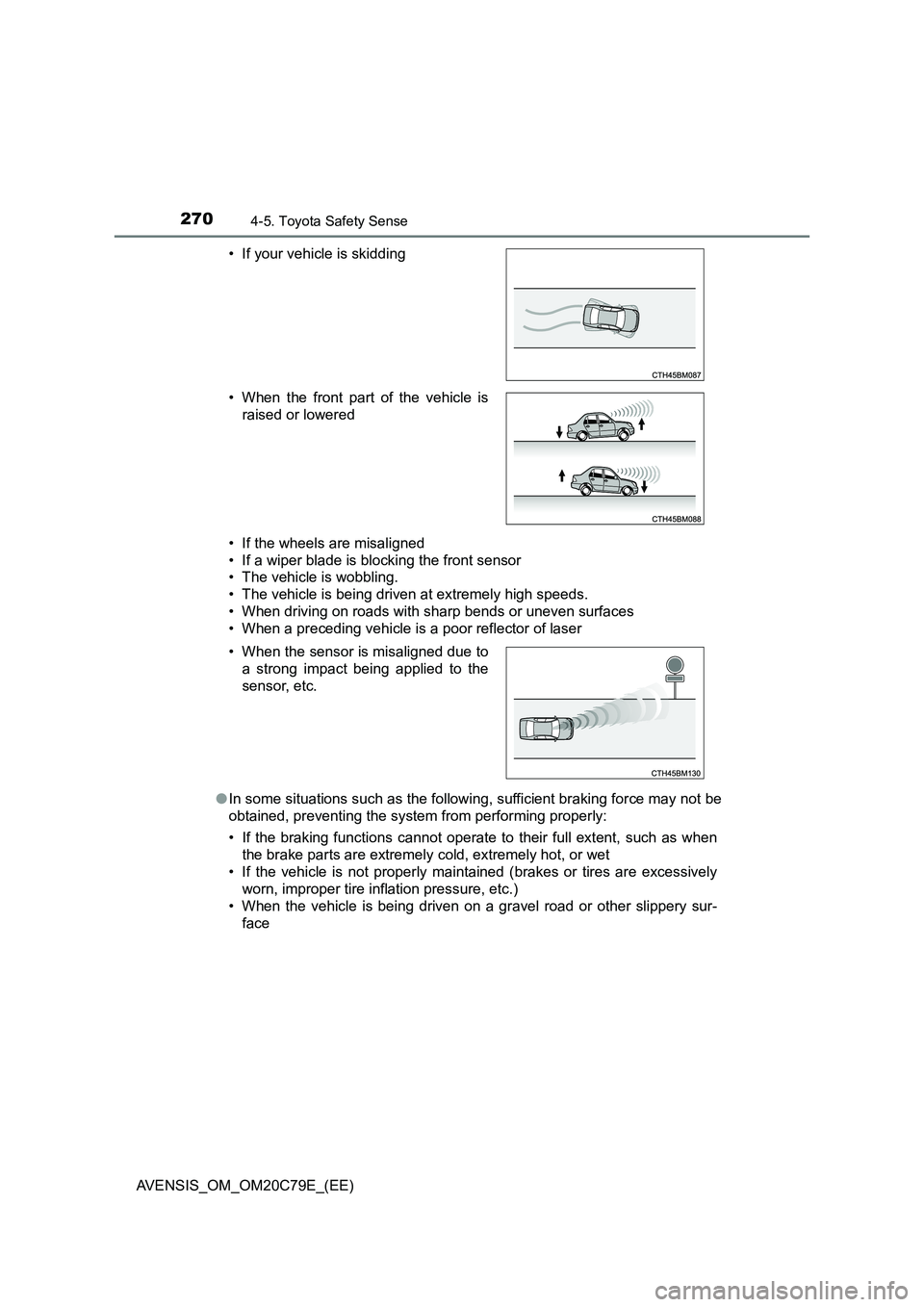
2704-5. Toyota Safety Sense
AVENSIS_OM_OM20C79E_(EE)
• If the wheels are misaligned
• If a wiper blade is blocking the front sensor
• The vehicle is wobbling.
• The vehicle is being driven at extremely high speeds.
• When driving on roads with sharp bends or uneven surfaces
• When a preceding vehicle is a poor reflector of laser
● In some situations such as the following, sufficient braking force may not be
obtained, preventing the system from performing properly:
• If the braking functions cannot operate to their full extent, such as when
the brake parts are extremely cold, extremely hot, or wet
• If the vehicle is not properly maintained (brakes or tires are excessively
worn, improper tire inflation pressure, etc.)
• When the vehicle is being driven on a gravel road or other slippery sur-
face
• If your vehicle is skidding
• When the front part of the vehicle is
raised or lowered
• When the sensor is misaligned due to
a strong impact being applied to the
sensor, etc.
Page 276 of 660
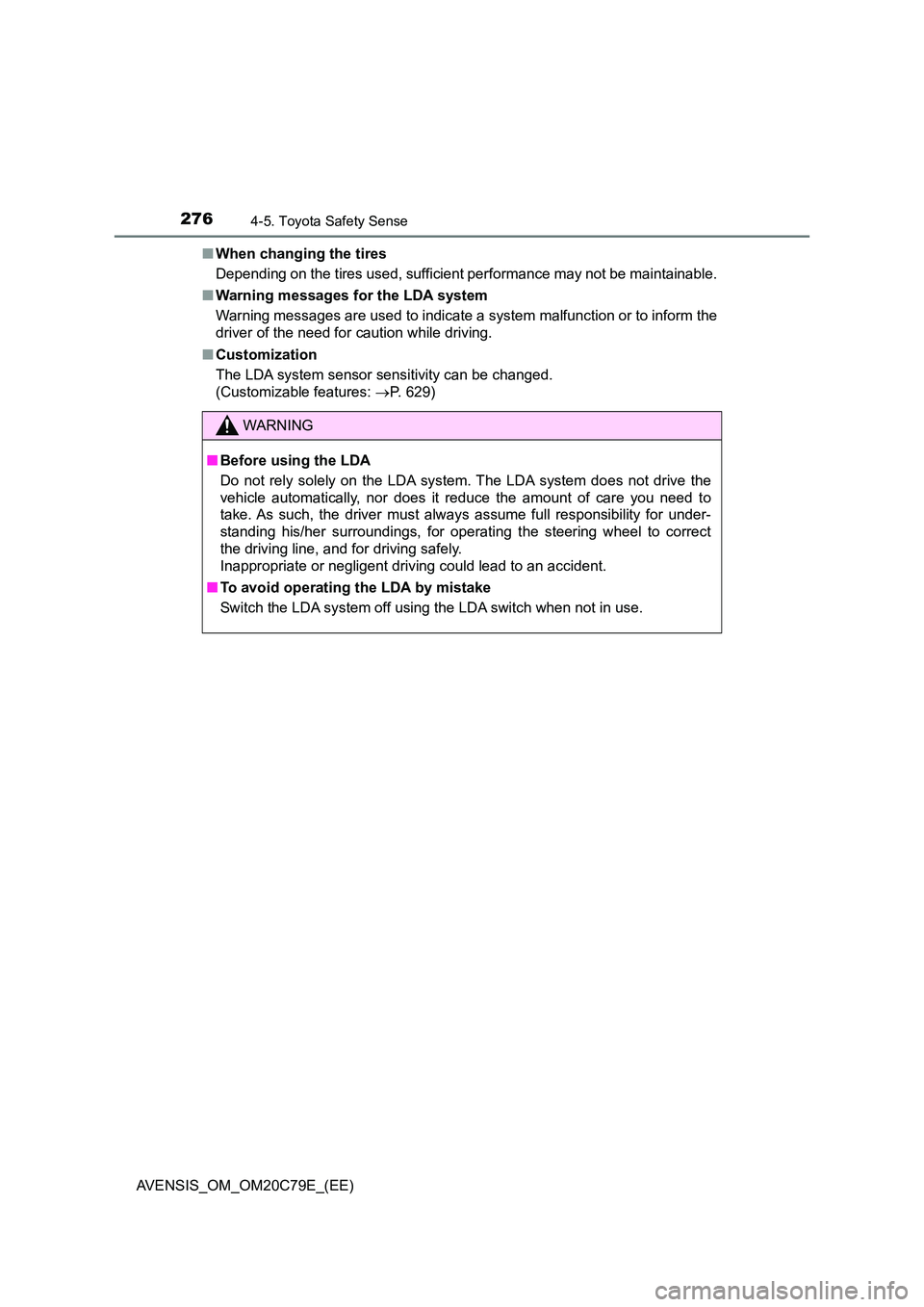
2764-5. Toyota Safety Sense
AVENSIS_OM_OM20C79E_(EE)
■ When changing the tires
Depending on the tires used, sufficient performance may not be maintainable.
■ Warning messages for the LDA system
Warning messages are used to indicate a system malfunction or to inform the
driver of the need for caution while driving.
■ Customization
The LDA system sensor sensitivity can be changed.
(Customizable features: P. 629)
WARNING
■Before using the LDA
Do not rely solely on the LDA system. The LDA system does not drive the
vehicle automatically, nor does it reduce the amount of care you need to
take. As such, the driver must always assume full responsibility for under-
standing his/her surroundings, for operati ng the steering wheel to correct
the driving line, and for driving safely.
Inappropriate or negligent driving could lead to an accident.
■ To avoid operating the LDA by mistake
Switch the LDA system off using the LDA switch when not in use.
Page 281 of 660
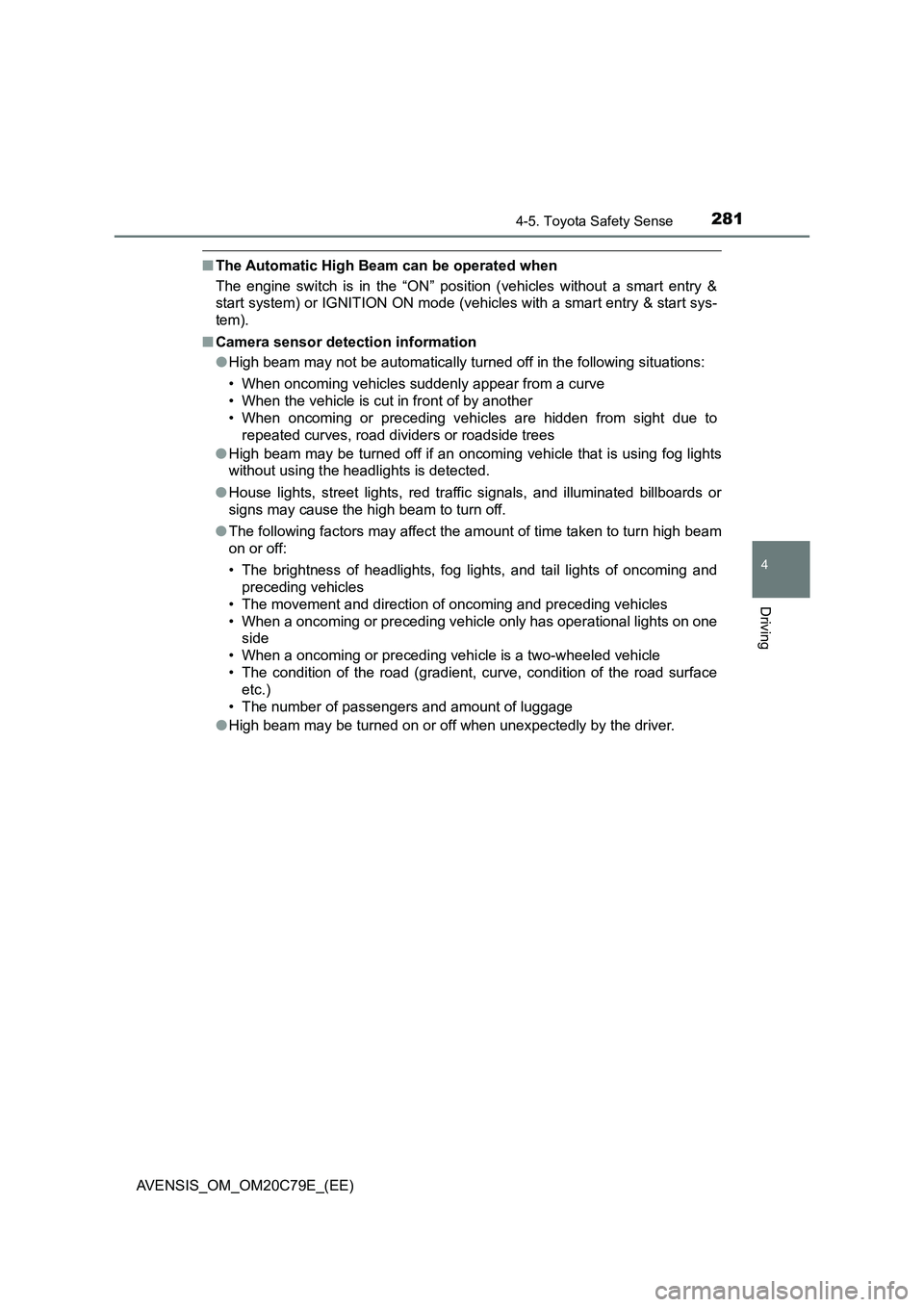
2814-5. Toyota Safety Sense
4
Driving
AVENSIS_OM_OM20C79E_(EE)
■The Automatic High Beam can be operated when
The engine switch is in the “ON” position (vehicles without a smart entry &
start system) or IGNITION ON mode (vehicles with a smart entry & start sys-
tem).
■Camera sensor detection information
●High beam may not be automatically turned off in the following situations:
• When oncoming vehicles suddenly appear from a curve
• When the vehicle is cut in front of by another
• When oncoming or preceding vehicles are hidden from sight due to
repeated curves, road dividers or roadside trees
●High beam may be turned off if an oncoming vehicle that is using fog lights
without using the headlights is detected.
●House lights, street lights, red traffic signals, and illuminated billboards or
signs may cause the high beam to turn off.
●The following factors may affect the amount of time taken to turn high beam
on or off:
• The brightness of headlights, fog lights, and tail lights of oncoming and
preceding vehicles
• The movement and direction of oncoming and preceding vehicles
• When a oncoming or preceding vehicle only has operational lights on one
side
• When a oncoming or preceding vehicle is a two-wheeled vehicle
• The condition of the road (gradient, curve, condition of the road surface
etc.)
• The number of passengers and amount of luggage
●High beam may be turned on or off when unexpectedly by the driver.
Page 288 of 660
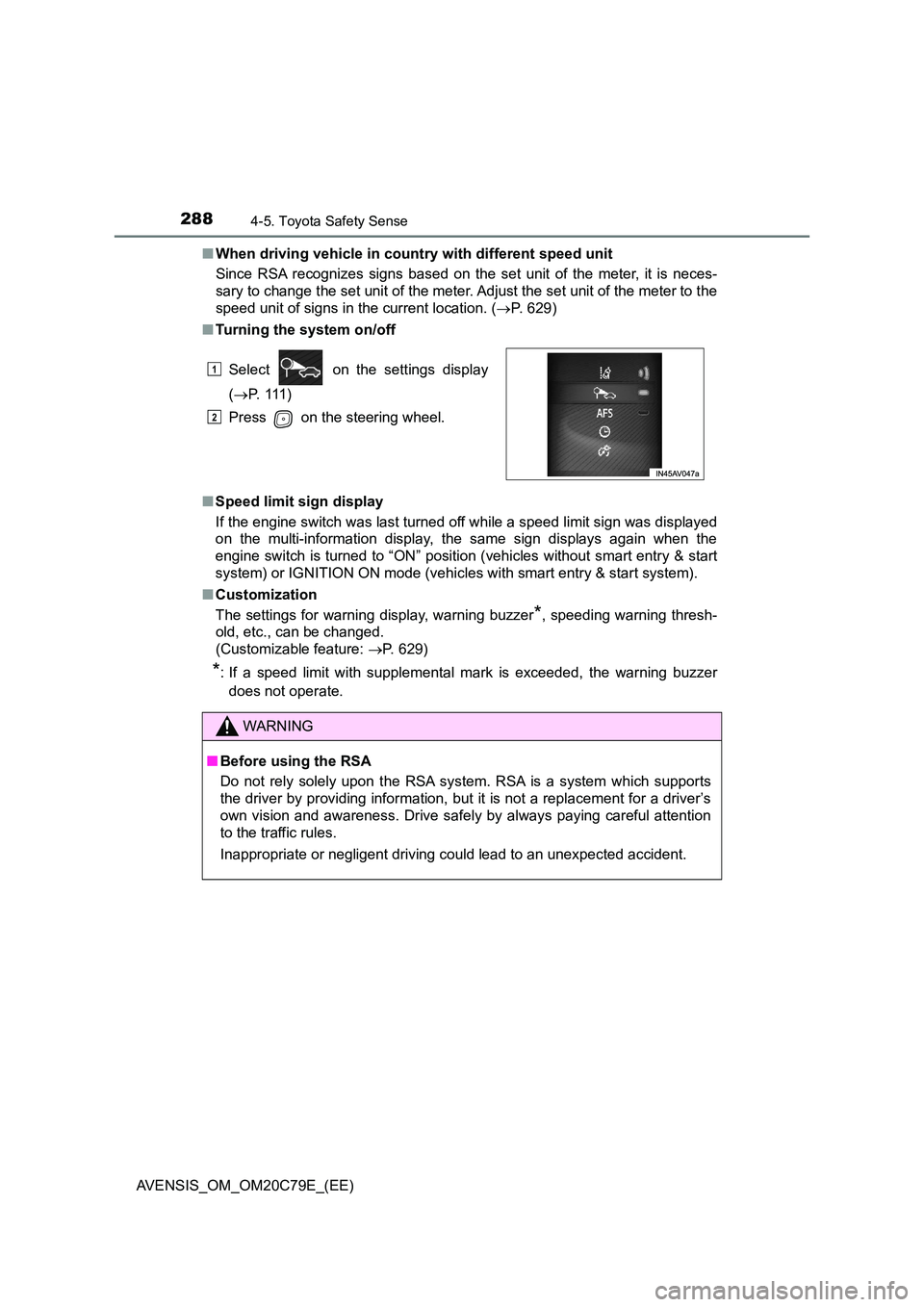
2884-5. Toyota Safety Sense
AVENSIS_OM_OM20C79E_(EE)
■ When driving vehicle in country with different speed unit
Since RSA recognizes signs based on the set unit of the meter, it is neces-
sary to change the set unit of the meter. Adjust the set unit of the meter to the
speed unit of signs in the current location. ( P. 629)
■ Turning the system on/off
■ Speed limit sign display
If the engine switch was last turned off while a speed limit sign was displayed
on the multi-information display, the same sign displays again when the
engine switch is turned to “ON” position (vehicles without smart entry & start
system) or IGNITION ON mode (vehicles with smart entry & start system).
■ Customization
The settings for warning display, warning buzzer*, speeding warning thresh-
old, etc., can be changed.
(Customizable feature: P. 629)
*: If a speed limit with supplemental mark is exceeded, the warning buzzer
does not operate.
Select on the settings display
( P. 111 )
Press on the steering wheel.
WARNING
■ Before using the RSA
Do not rely solely upon the RSA system. RSA is a system which supports
the driver by providing information, but it is not a replacement for a driver’s
own vision and awareness. Drive safely by always paying careful attention
to the traffic rules.
Inappropriate or negligent driving could lead to an unexpected accident.
1
2
Page 297 of 660
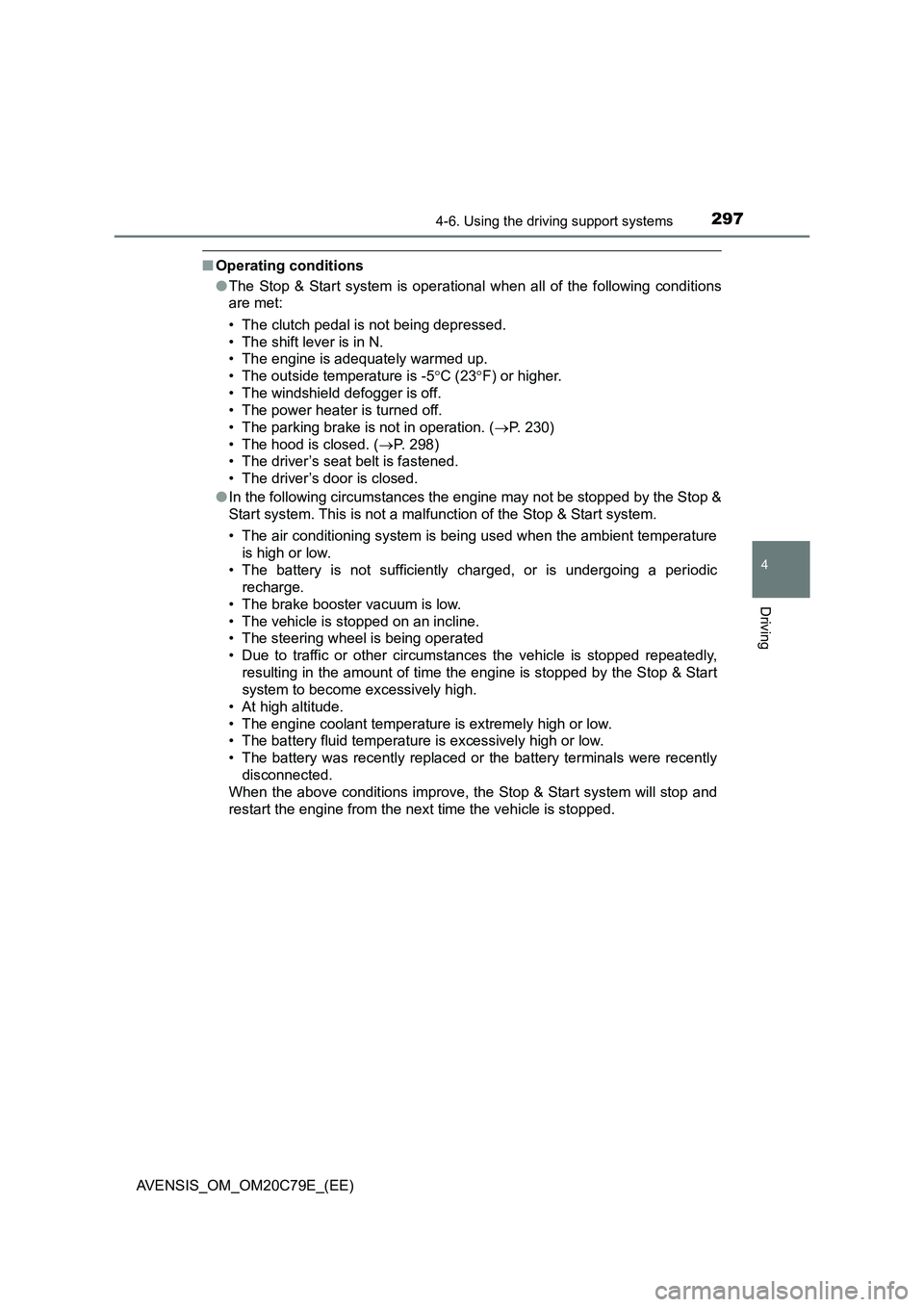
2974-6. Using the driving support systems
4
Driving
AVENSIS_OM_OM20C79E_(EE)
■Operating conditions
●The Stop & Start system is operational when all of the following conditions
are met:
• The clutch pedal is not being depressed.
• The shift lever is in N.
• The engine is adequately warmed up.
• The outside temperature is -5C (23F) or higher.
• The windshield defogger is off.
• The power heater is turned off.
• The parking brake is not in operation. (P. 230)
• The hood is closed. (P. 298)
• The driver’s seat belt is fastened.
• The driver’s door is closed.
●In the following circumstances the engine may not be stopped by the Stop &
Start system. This is not a malfunction of the Stop & Start system.
• The air conditioning system is being used when the ambient temperature
is high or low.
• The battery is not sufficiently charged, or is undergoing a periodic
recharge.
• The brake booster vacuum is low.
• The vehicle is stopped on an incline.
• The steering wheel is being operated
• Due to traffic or other circumstances the vehicle is stopped repeatedly,
resulting in the amount of time the engine is stopped by the Stop & Start
system to become excessively high.
• At high altitude.
• The engine coolant temperature is extremely high or low.
• The battery fluid temperature is excessively high or low.
• The battery was recently replaced or the battery terminals were recently
disconnected.
When the above conditions improve, the Stop & Start system will stop and
restart the engine from the next time the vehicle is stopped.
Page 298 of 660
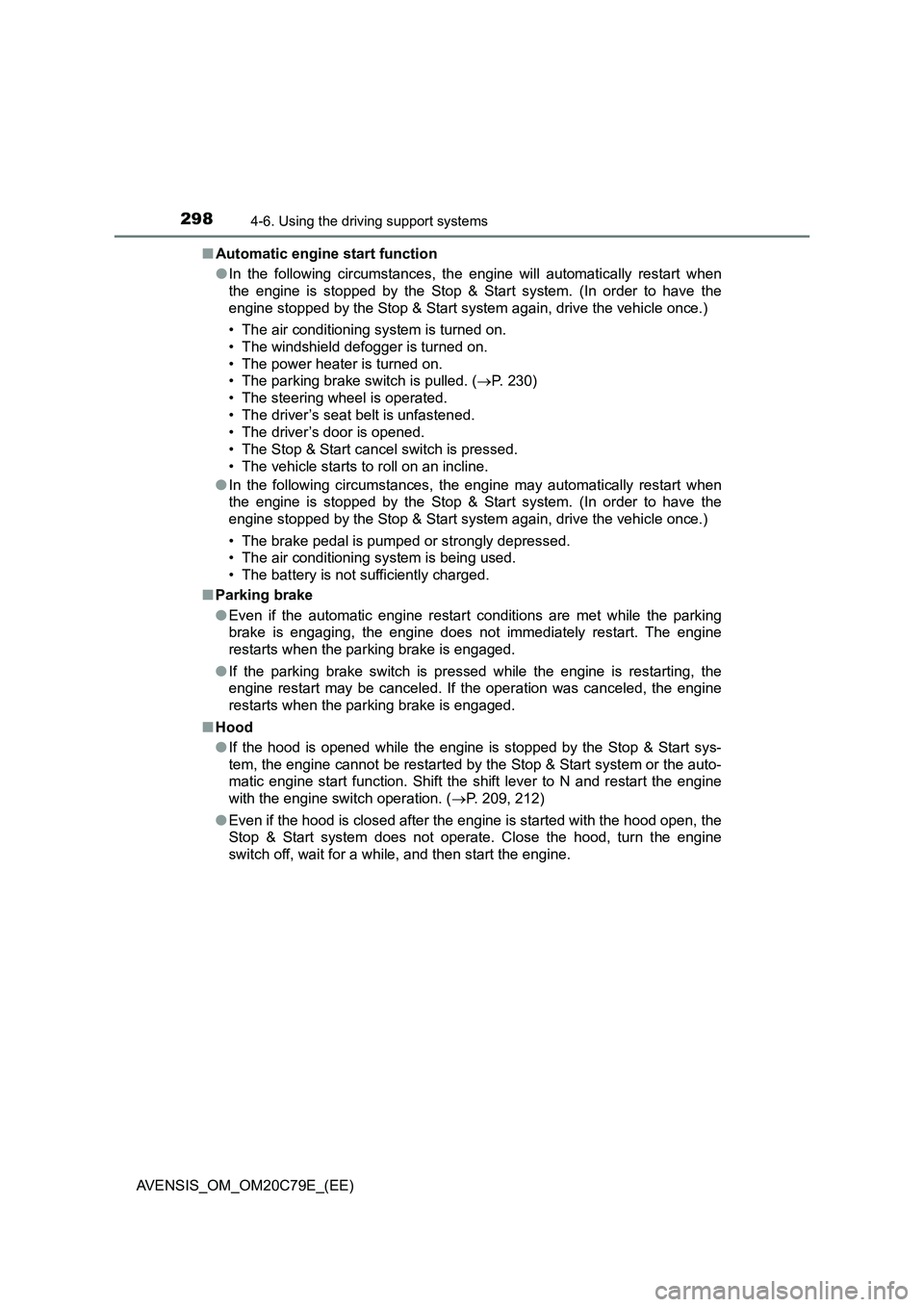
2984-6. Using the driving support systems
AVENSIS_OM_OM20C79E_(EE)■Automatic engine start function
●In the following circumstances, the engine will automatically restart when
the engine is stopped by the Stop & Start system. (In order to have the
engine stopped by the Stop & Start system again, drive the vehicle once.)
• The air conditioning system is turned on.
• The windshield defogger is turned on.
• The power heater is turned on.
• The parking brake switch is pulled. (P. 230)
• The steering wheel is operated.
• The driver’s seat belt is unfastened.
• The driver’s door is opened.
• The Stop & Start cancel switch is pressed.
• The vehicle starts to roll on an incline.
●In the following circumstances, the engine may automatically restart when
the engine is stopped by the Stop & Start system. (In order to have the
engine stopped by the Stop & Start system again, drive the vehicle once.)
• The brake pedal is pumped or strongly depressed.
• The air conditioning system is being used.
• The battery is not sufficiently charged.
■Parking brake
●Even if the automatic engine restart conditions are met while the parking
brake is engaging, the engine does not immediately restart. The engine
restarts when the parking brake is engaged.
●If the parking brake switch is pressed while the engine is restarting, the
engine restart may be canceled. If the operation was canceled, the engine
restarts when the parking brake is engaged.
■Hood
●If the hood is opened while the engine is stopped by the Stop & Start sys-
tem, the engine cannot be restarted by the Stop & Start system or the auto-
matic engine start function. Shift the shift lever to N and restart the engine
with the engine switch operation. (P. 209, 212)
●Even if the hood is closed after the engine is started with the hood open, the
Stop & Start system does not operate. Close the hood, turn the engine
switch off, wait for a while, and then start the engine.
Page 301 of 660
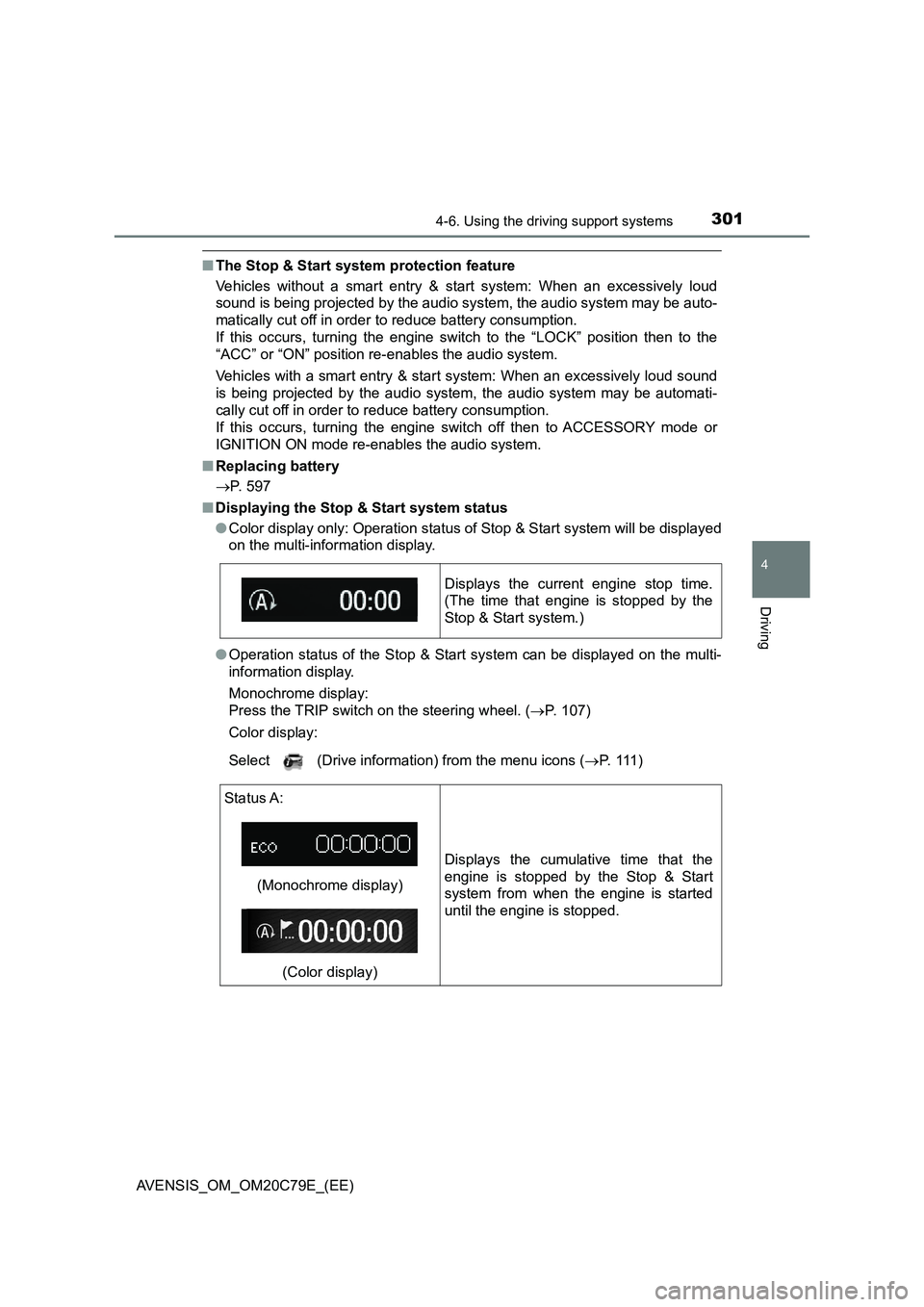
3014-6. Using the driving support systems
4
Driving
AVENSIS_OM_OM20C79E_(EE)
■The Stop & Start system protection feature
Vehicles without a smart entry & start system: When an excessively loud
sound is being projected by the audio system, the audio system may be auto-
matically cut off in order to reduce battery consumption.
If this occurs, turning the engine switch to the “LOCK” position then to the
“ACC” or “ON” position re-enables the audio system.
Vehicles with a smart entry & start system: When an excessively loud sound
is being projected by the audio system, the audio system may be automati-
cally cut off in order to reduce battery consumption.
If this occurs, turning the engine switch off then to ACCESSORY mode or
IGNITION ON mode re-enables the audio system.
■Replacing battery
P. 597
■Displaying the Stop & Start system status
●Color display only: Operation status of Stop & Start system will be displayed
on the multi-information display.
●Operation status of the Stop & Start system can be displayed on the multi-
information display.
Monochrome display:
Press the TRIP switch on the steering wheel. (P. 107)
Color display:
Select (Drive information) from the menu icons (P. 1 1 1 ) Displays the current engine stop time.
(The time that engine is stopped by the
Stop & Start system.)
Status A:
(Monochrome display)
(Color display)Displays the cumulative time that the
engine is stopped by the Stop & Start
system from when the engine is started
until the engine is stopped.